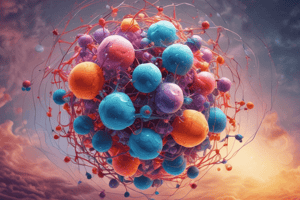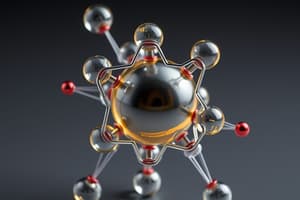Podcast
Questions and Answers
Particles can only be atoms, not molecules or ions.
Particles can only be atoms, not molecules or ions.
False (B)
The particle model can explain the differences between solids, liquids, and gases.
The particle model can explain the differences between solids, liquids, and gases.
True (A)
Solids can be easily compressed or squashed due to the particles being close together.
Solids can be easily compressed or squashed due to the particles being close together.
False (B)
The particles in solids move by freely flowing around each other.
The particles in solids move by freely flowing around each other.
Water exists as a solid, liquid, and gas.
Water exists as a solid, liquid, and gas.
Solids can be easily compressed or squashed due to the particles being close together.
Solids can be easily compressed or squashed due to the particles being close together.
The particles in solids are arranged in a regular way.
The particles in solids are arranged in a regular way.
Particles can be atoms, molecules, or ions.
Particles can be atoms, molecules, or ions.
Water exists as a solid, liquid, and gas.
Water exists as a solid, liquid, and gas.
The particles in solids move only by vibrating about a fixed position.
The particles in solids move only by vibrating about a fixed position.
Flashcards
Particle Model Explanation
Particle Model Explanation
The particle model explains the different properties and behaviors of solids, liquids, and gases based on the arrangement and movement of their particles.
States of Water
States of Water
Water can exist in three states: solid (ice), liquid (water), and gas (steam).
Types of Particles
Types of Particles
Particles can be atoms, molecules, or ions, depending on the substance.
Particle Arrangement in Solids
Particle Arrangement in Solids
Signup and view all the flashcards
Particle Movement in Solids
Particle Movement in Solids
Signup and view all the flashcards
Study Notes
Particles and States of Matter
- Almost everything is made of particles, which can be atoms, molecules, or ions.
- Particles behave differently in solids, liquids, and gases.
- The particle model explains the differences between solids, liquids, and gases.
Solids
- Many materials are solid, including paper, bricks, wood, metal, and ice.
- Particles in solids are very close together and cannot usually be compressed or squushed.
- Forces of attraction between particles hold them together and keep them in place.
- Particles in solids are arranged in a regular way.
- Particles in solids move only by vibrating about a fixed position, giving solids a fixed shape.
Water
- Water exists as a solid, liquid, and gas.
- Solid water is also known as ice.
- Gaseous water is also known as water vapor.
Studying That Suits You
Use AI to generate personalized quizzes and flashcards to suit your learning preferences.




